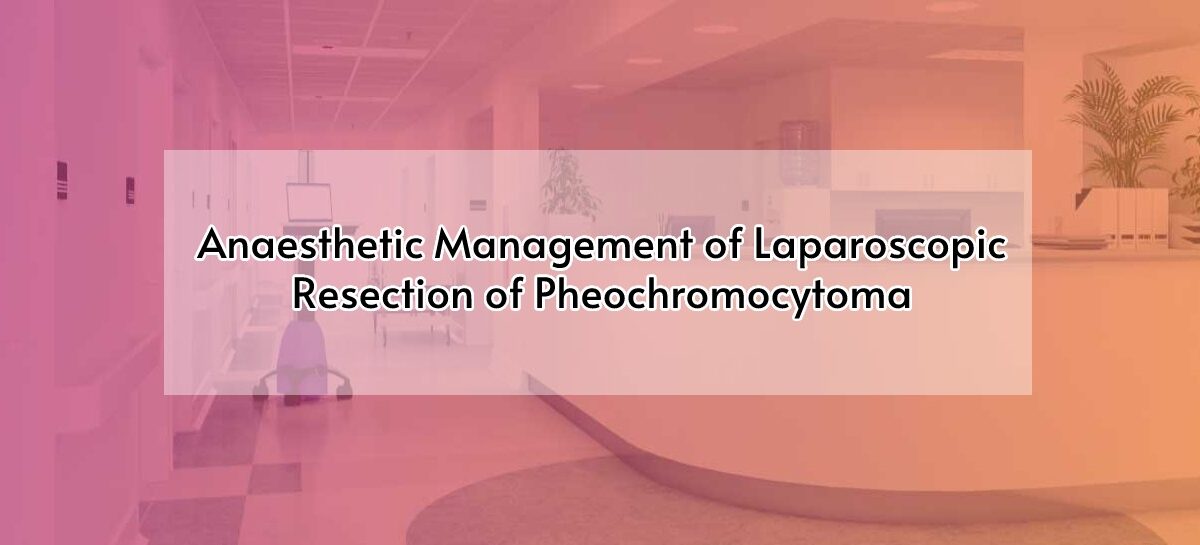Introduction
Pheochromocytoma is a tumour arising from chromaffin cells in the adrenal medulla or other paraganglia of the sympathetic nervous system.
Pathophysiology
Patients present with variety of symptoms that reflect excessive secretion of norepinephrine, epinephrine or dopamine into the circulation.
Presenting Symptoms
- Sustained and refractory hypertension
- Headache
- Palpitation
- Sweating and blanching
- Panic attack
Confirmatory Test
24-hour urinary free catecholamines (metanephrines)
Anaesthetic Considerations
- Prolonged exposure to high levels of circulating norepinephrine results in arteriolar and venous constriction that causes decrease in circulating blood volume.
- Induction may cause venodilatation and profound arterial hypotension.
- Patient might have increased blood glucose level as a result of glycogenolysis with impaired insulin release by islet cells of pancreases
- Persistent untreated hypertension might result in left ventricular failure with systemic arterial shutdown
- Prolonged exposure to increased concentration of circulating catecholamines might cause dilated cardiomyopathy with left ventricle failure.
- By contrast, hypertrophic cardiomyopathy can result from norepinephrine induced systemic hypertension.
- High output failure might result from excessive epinephrine production with cardiomyopathy.
- Acute pulmonary edema may complicate intraoperative management of pheochromocytoma.
Perioperative Pharmacological Control
- Alpha-blockers: are used in treatment of pheochromocytoma to suppress the hypertension.
- Phenoxybenzamine (non-selective alpha adrenoceptor antagonist)It is a Non-competitive blockade (covalent binding)
- Prazosin: selective competitive alpha-1 adrenergic blocker
Alpha 2 blockade causes uninhibited norepinephrine release from the cardiac sympathetic nerve which results in chronotropic and inotropic effects, that requires adjuvant beta-adrenergic blockade.
- Beta-adrenergic antagonist: Commonly used drugs are selective beta-1 antagonist (atenolol100mg/day, bisoprolol 10 to 20mg/day) or combined alpha and beta-blocker (labetalol100 to 400mg/day, carvedilol 12.5 to 50 mg/day).
Suppression of beta adrenergic mediated cardiac sympathetic activity in the absence of adequate arteriolar dilation may precipitate pulmonary edema in such patients.
Beta-blockers are used:
- To limit excessive tachycardia with or without cardiac arrythmias that is seen predominantly in epinephrine and dopamine secreting tumours.
- To block excessive cardiac sympathetic drive secondary to suppression of presynaptic regulating mechanism by Alpha blockers.
Case Scenario
49-year-old gentleman weighing 82kg with a medical history of diabetes on Oha and insulin, systemic hypertension on tab prazosin 5mg tds, tab telmisartan 40mg od, tab concor 5mg bd, hypothyroidism on tab eltroxin 100mcg od ,coronary artery disease (s/p ptca )on tab aspirin 75mg od and h/o permanent pacemaker insertion for complete heart block. He was diagnosed to have pheochromocytoma of left adrenal gland and was planned for laparoscopic left adrenalectomy.
Investigations revealed normal renal parameters and coagulation profile. He had raised plasma metanephrine levels. Echo findings revealed hypertrophic cardiomyopathy with normal systolic left ventricular function.
Preparation
Last pre-op dose of alpha blocker was given 8hours before surgery. Peripheral access and arterial cannulation were placed under L/A. Haemodynamic monitoring was established with ecg and pulse oximetry.
Anaesthetic Management
- Preoxygenation
- Induction with fentanyl 2mcg/kg and propofol 2mg/kg followed by cisatracurium 0.15mg/kg.
- Following tracheal intubation, nasogastric tube was inserted
- Lungs were ventilated with tidal volume of 10ml/kg at 12 breaths/min using circle system with soda lime absorber.
- Anaesthesia was maintained with sevoflurane in N2:O2 to achieve MAC value of1.
- Patient was placed in right lateral position.
- After sterile draping, pneumoperitoneum was created.
- Manipulation of tumour, however gently performed, caused a brisk haemodynamic response, predominantly a pressor response.
- G/A was supplemented with intravenous infusion of propofol, injection morphine & incremental doses of injection labetalol to control hypertension.
- Magnesium was used to suppress the refractory hypertension. It inhibits the release of catecholamines from the normal adrenal medulla and from adrenergic nerve terminals. Loading dose of 40-60mg/kg followed by 1to 2gm/hr (designed to achieve serum magnesium concentration 2-4mmol/l) was given.
- The moment, the surgeon ligated the predominant /last major emptying vein from tumour, there was an exponential drop in arterial pressure.
- Despite vigorous attempts to fill the circulation with fluids and colloids(gelatin) and with incremental doses of phenylephrine, patient required noradrenaline infusion to maintain the CVP more than 8mmhg.
- The refractory hypotension is an extension of the preoperative contracted blood volume due to high circulating levels of catecholamines and because of the catecholamine output of contralateral adrenal gland was effectively suppressed and the patient’s adrenoceptors were downregulated.
- Now in absence of catecholamines, the only source of nor-epinephrine will be from adrenergic nerve endings. This depends upon generalised sympathetic nervous activity that is diminished during anaesthesia as a result of lack of arousal and its effects in stimulating hypothalamus .
- Considering this patient’s cardiac status (HOCM, post ptca, s/p PPI) we had decided to ventilate the patient electively for few hours or until his volume status and haemo dynamics were stabilised without major supports.
- The following day, the patient was weaned from ventilator and extubated. He required minimal dose of noradrenaline infusion for a couple of hours, after which he was sent to ward.
Conclusion
Preoperative optimization plays an important role in decreasing the high incidence of perioperative morbidity and mortality. Alpha- blockade, especially with selective alpha-1 antagonist is vital in these patients. Adjunct antihypertensive drugs include beta-blockers and calcium channel blockers. Intensive haemodynamic monitoring instituted intraoperatively has to be continued in the postoperative period as well, to tide over the initial period of hypotension after tumor removal. Patients with pheochromocytoma or paraganglioma should be managed by an experienced team of endocrinologist, endocrine surgeons and Anaesthesiologist.
 Dr. I. Hemalatha
Dr. I. Hemalatha
Consultant Anaesthesiologist
Kauvery Hospital Chennai



